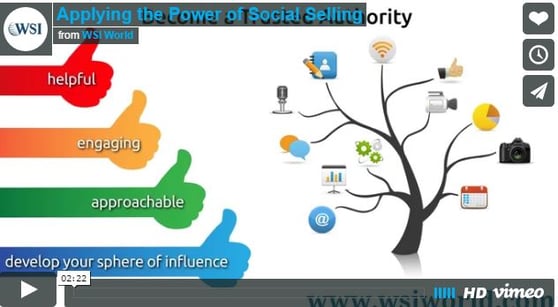Are you looking for ways to use social selling to grow your business? If so, then you've come to the right blog. You don't need to be a techie to know that social media is changing many things about the world - most obviously, how we communicate with our family and friends. If you do follow the startup, tech, and financial worlds, you understand that new ideas and technologies - social media among them - are shifting much more than just the way you keep in touch with old friends from high school or your aunt down in Florida. No, these advancements are changing everything, perhaps most importantly, the environment in which buyers and sellers conduct their business.
These days, both personal and professional consumers want to research, compare, and inform their own buying decisions. Much of this research takes place on the websites and social media platforms of the digital world, which changes the game for salespeople. Customers no longer want to be cornered, bullied, or told what to buy; they will seek help once they're ready, but they want to be assisted on their turf. That turf is online. That turf is social media.
Unfortunately, many companies and sales managers in ill-equipped industries see social selling as a threat, mainly because they don't have the knowledge and understanding to embrace the new medium. In reality, social selling is an excellent opportunity for businesses of all shapes and sizes to leverage web technology and deliver value and insight to the customer in an open and comfortable environment. Check out our social selling master course to navigate this powerful tool.
What is Social Selling?
Social selling is the modern approach to building relationships with potential customers through social media. It’s not about spamming people with sales pitches or cold calling—it’s about connecting with your audience where they already spend time online, sharing valuable insights, and building trust over time. Think of it as the digital equivalent of networking at a conference, but instead of handshakes and business cards, you’re engaging with likes, comments, and meaningful conversations. By focusing on helping rather than selling, businesses can position themselves as trusted advisors, making it easier to guide prospects and customers toward solutions that meet their needs.
To succeed, social sellers must focus on social selling best practices, such as building a personal brand, engaging in social listening to understand what people are saying, and using social selling tools to track interactions and opportunities. These practices help businesses use social networks effectively and enhance their social selling efforts for long-term social selling success.
Benefits of Social Selling
Social selling offers several benefits that can transform how businesses connect with their audience and drive sales. For one, it helps build authentic relationships with potential customers by engaging them more personally and meaningfully on platforms like Facebook and Instagram. This approach fosters trust and credibility, essential in today’s buyer-driven marketplace.
Effective social selling strategies allow businesses to reach a broader audience, as selling platforms open doors to new markets and customer segments. Social selling provides real-time insights into customer needs and preferences through social listening and engagement, enabling customized solutions. Focusing on a buyer’s ideal customer profile and providing relevant content throughout the buying process can help sales teams nurture new relationships and turn them into repeat business.
Businesses can make their social selling efforts more impactful by learning how to find and share the right type of content and understanding the best content to post. Ultimately, social selling helps increase lead generation and conversion rates while reducing reliance on outdated methods like cold calling, which many B2B buyers no longer respond to.
Tips for Social Selling Success
1. Identify Buyer Personas
You can't sell anything without developing relationships, and social selling begins and ends with learning the buyer personas of your target market. This includes identifying your buyers' interests, job titles and responsibilities, social profiles, and level of social engagement.
2. Intelligence Is Key
To make a strong social connection and ultimately enter a potential customer's sphere of influence, you need to know and understand them. Rather than being fake or guessing, get to know your audience by listening and observing them before you start talking. That way, you'll be able to more accurately assess the challenges and requirements of your potential customers.
3. Create a Content Marketing Plan
Now that you understand your target market and its challenges, you can begin creating content that caters to their needs and interests. By devising a content marketing plan, you'll ensure that your content's creation and publication are practical and organized. Part of your content marketing plan should involve syndicating other relevant and insightful content from your industry via your social media channels.
4. Become A Trusted Authority
After you've taken the time to listen to and integrate with your target audience, you'll be well on your way to becoming a trusted authority within your industry. To continue to build trust within your sphere, you should remain approachable, engaging, and, most of all, helpful.
5. Monitor and Improve
It's only through tracking tools and techniques that you'll be able to determine how successful you are at applying the power of social selling in steps one through four. Monitoring social activity and engagement will give you an idea of the topics and discussions that resonate the most with your audience. Remain focused on the things that are working, and cut out the ones that aren't catching on.
What is the Social Selling Index?
The Social Selling Index (SSI) is a metric developed by LinkedIn to measure how effectively you are using the platform for selling with social media. It evaluates your performance across four key areas:
- Establish your personal brand by sharing relevant content and building credibility.
- Find and engage with prospects who match your ideal customer profile.
- Using social media to build trust by participating in meaningful conversations.
- Building authentic relationships that lead to long-term business opportunities.
The social selling index score—on a scale of 0 to 100—tells you how well you leverage LinkedIn to connect with potential clients, share valuable content, and grow your network. A higher SSI score indicates that you’re successfully applying effective social selling strategies, making it an excellent platform to track progress and refine your sales strategy. The SSI can guide best practices for sales and marketing teams and align efforts to improve results.
By leveraging social selling platforms like LinkedIn and understanding the KPIs for successful social selling, you can start engaging with customers and prospects, which will help you find new opportunities and ultimately sell products or services more effectively.
Learn the Power of Social Selling and Grow Your Business
WSI is ready to help you implement digital marketing strategies that connect with your audience and build trust. Reach out to our team today to get started with social selling for your business.






